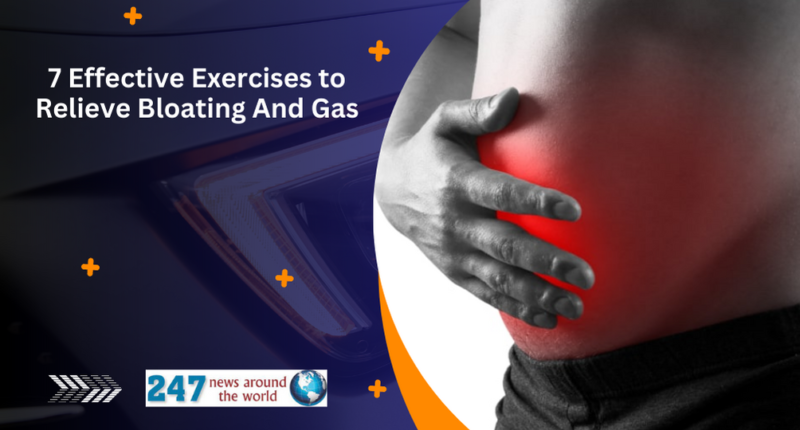A look at “7 Effective Exercises to Relieve Bloating And Gas” Bloating can be uncomfortable and distressing, causing your stomach to feel full, tight, and swollen. Luckily, there are several exercises that can help alleviate bloating and promote better digestion. Incorporating these exercises into your routine can provide relief and contribute to a healthier, happier you.

7 Effective Exercises to Relieve Bloating And Gas
Bloating and gas can be uncomfortable and even embarrassing, but the good news is that there are effective exercises you can incorporate into your routine to help alleviate these symptoms. Whether it’s after a heavy meal or due to certain dietary choices, bloating and gas can be managed through targeted physical activity. In this article, we’ll explore seven exercises that can provide relief and promote digestive comfort. Here are seven effective exercises to consider:
1. Deep Belly Breathing
Deep belly breathing, also known as diaphragmatic breathing, is a simple yet powerful exercise to relieve bloating. Find a quiet, comfortable space to sit or lie down. Place one hand on your chest and the other on your abdomen. Inhale deeply through your nose, allowing your abdomen to rise while keeping your chest relatively still. Exhale slowly through your mouth, ensuring your abdomen contracts. Repeat this process for several minutes, focusing on deep, controlled breaths.

2. Child’s Pose
Child’s Pose is a yoga posture that gently massages the abdominal area and promotes relaxation. Start by kneeling on the floor with your big toes touching and knees apart. Sit back on your heels and lower your torso between your thighs, extending your arms in front of you. Hold this pose for a few deep breaths, feeling the stretch along your back and abdomen. Child’s Pose can help release trapped gas and ease bloating discomfort.

3. Twisting Yoga Poses
Twisting yoga poses like the Supine Twist or Seated Spinal Twist are excellent for stimulating digestion and relieving bloating. These poses involve gentle twists of the torso, which can help massage the abdominal organs and encourage the release of gas. Practice these poses mindfully, taking deep breaths as you twist to enhance the stretch and promote relaxation.

4. Walking
Simple yet effective, taking a brisk walk can aid digestion and reduce bloating. Walking helps to stimulate the muscles in your abdomen, encouraging the movement of food through your digestive system. Aim for a 20 to 30-minute walk after meals to experience the benefits. Not only does walking support digestion, but it also contributes to overall cardiovascular health.

5. Leg Raises
Leg raises are a great way to engage your core muscles and promote bowel movement. Lie flat on your back with your legs extended. Slowly raise both legs towards the ceiling, then lower them back down without touching the floor. Repeat this movement for several repetitions, feeling the activation in your lower abdomen. Leg raises can help relieve gas buildup and contribute to a flatter stomach.

6. Pelvic Tilts
Pelvic tilts are effective for strengthening the abdominal muscles and improving digestion. Lie on your back with your knees bent and feet flat on the floor. Gently tilt your pelvis upward, pressing your lower back into the floor. Hold for a few seconds, then release. Repeat this motion for several reps. Pelvic tilts can enhance blood flow to the digestive organs, helping to alleviate bloating.

7. Cat-Cow Stretch
The Cat-Cow Stretch is a yoga sequence that promotes flexibility in the spine and massages the abdominal organs. Begin on your hands and knees, aligning your wrists under your shoulders and your knees under your hips. Inhale as you arch your back, lifting your tailbone and head (Cow Pose). Exhale as you round your spine, tucking your chin to your chest (Cat Pose). Repeat this flow for several breaths, syncing movement with your breath.

These are just a few of the many exercises that can help to reduce bloating. If you are feeling bloated, it is important to listen to your body and find exercises that feel good to you. You may also want to try some gentle stretching or yoga poses.
In addition to exercise, there are other things you can do to reduce bloating, such as:
- Eating a healthy diet that is low in processed foods and high in fiber.
- Drinking plenty of water.
- Avoiding foods that trigger bloating, such as dairy, gluten, and beans.
- Managing stress levels.
If you are still feeling bloated after trying these tips, you may want to talk to your doctor. There may be an underlying medical condition that is causing your bloating.
Conclusion
Incorporating these seven effective exercises into your routine can make a significant difference in relieving bloating and gas. From deep breathing to yoga poses and core-engaging exercises, each of these techniques contributes to better digestion and a more comfortable abdomen.
FAQs
Q1: How often should I perform these exercises?
A1: Aim for at least three times a week, but listen to your body and adjust as needed.
Q2: Can I do these exercises after a heavy meal?
A2: Yes, but it’s best to wait about an hour after eating to avoid discomfort.
Q3: Are there any exercises to avoid if I have a pre-existing medical condition?
A3: If you have concerns, consult a healthcare professional before starting a new exercise routine.
Q4: Can these exercises help with long-term digestive issues?
A4: These exercises can provide relief, but if you have chronic digestive problems, it’s advisable to seek medical advice.
Q5: Should I warm up before doing these exercises?
A5: Yes, a gentle warm-up can help prevent strain and injury, especially for yoga-related poses.
You may also link | 7 Effective Exercises to Relieve Neck and Shoulder Pain
Last Updated on February 18, 2025 by 247 News Around The World






